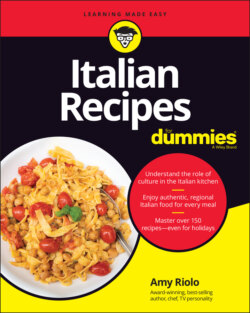Читать книгу Italian Recipes For Dummies - Amy Riolo - Страница 50
Sampling Everyday Menus for Every Season
ОглавлениеTo me, making menus is one of the most pleasurable experiences in life. In a well-planned menu, seasonality, nutrition, taste, texture, aroma, and terroir (flavors imparted by the local terrain) work together through a series of courses to create a perfectly balanced eating experience.
While it might sound intimidating to some, many of the principles of food pairing are so embedded in our memories that it seems as though certain foods just naturally go together. If you’ve never created a menu before, use the following guidelines until you are comfortable with the process. Notice how the elements of the Italian meals you enjoy the most work together, and apply those principles in your own kitchen.
Here are a few tips:
Traditional, complete Italian meals consist of an appetizer, a first course, a second course with a side dish, salad, fruit and nuts or cheese, and/or a dessert and a cup of espresso followed by a digestivo, or after dinner liqueur (such as grappa, Amaro, Sambuca, or Limoncello) — served in that order.
In today’s hurried culture, even in Italy, the full traditional meal is often only served on Sundays (when most Italians still participate in the ritual family meal), when entertaining, in fine-dining situations, or on holidays.
Workday lunches may now consist of a primo (first course), salad, and espresso (often omitting the second course).
Workday dinners may consist of a second course, side dish, salad, fruit and cheese, and espresso (often omitting the appetizer and first course).
Pasta, risotto, or gnocchi is typically present in Italian lunches.
Fresh, seasonal, local, organic foods are always preferred.
Pasta dishes are never preceded by soup. Soup can be enjoyed on its own, or as a first course instead of pasta.
